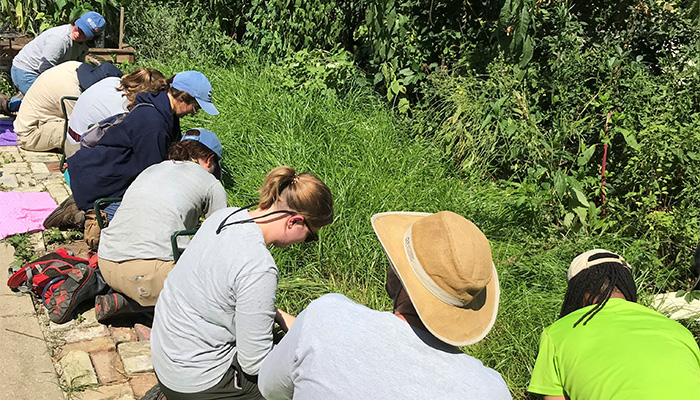Each blade of tall, green sweetgrass (wiingashk in Ojibwe) and sprawling sage (bashkodejiibik in Ojibwe) sway from side to side in the light fall breeze outside of Trailside Museum of Natural History in River Forest. Together, they form a garden, which was installed in 2023 to be used for a handful of different purposes by the local Native American community.
“Whether it’s being used to teach young people about different ceremonial medicines or how they’re used like sage is used in smudging, like cleaning a room, there are subtle differences to all the different tribes in the way that these different medicines are used,” said Adam Kessel, director at Trailside. “We’re growing sage and sweetgrass here as a way for community members to have access to those medicines within our grounds.”
Sweetgrass and sage are two of the four sacred medicines in Native American culture, joining cedar (giizhik in Ojibwe) and tobacco (asemaa in Ojibwe). Sweetgrass is used for braiding, which is typically done in a group setting to bring communities together.
Kessel, who helped grow the sweetgrass and sage garden, says they were able to harvest for the first time this year after establishing enough plants in the garden. The Forest Preserves then gifted these medicines to its partners, the American Indian Center of Chicago, American Indian Health Services of Chicago and Northwestern University’s Center for Native American and Indigenous Research.
“Any of our partner organizations can ask for it,” Kessel said. “Because it’s so new we’ve really only gifted it out to a handful. And I would expect that there’s going to be more requests, as more folks in community begin to know about it.”
The need for these sacred medicines is real. Gina Roxas, the executive director of the Trickster Cultural Center in Schaumburg, says the Chicagoland Native American community is made up of people from different nations, each with different traditions and beliefs. She says these people must travel back to their reservations in California, Nebraska or even Canada to get these plants.
“These medicines are used for praying and there’s emergency times where those might be needed,” said Roxas. “To have to travel that far away in an emergency sometimes isn’t conducive, and bringing more access to these medicines ensures that our traditions and our cultures are past down from generation to generation.”
The sweetgrass garden was made possible by Forest Preserves staff who worked with representatives from Native communities, including Roxas and Trickster, which played an integral part.
“I just so happened to have made a contact with someone who had an abundance of sweetgrass, and they gifted us quite a bit of sweetgrass plants,” Roxas said. “And so, we gifted Adam a palette of sweetgrass, as well as other folks in the community. His garden, it took really well so we’re really happy for that.”
Roxas believes the sweetgrass is in good hands at Trailside and its story is being told.
“It’s not just the plant itself, it’s also the stories that go along with it,” Roxas said. “Sweetgrass for many Native American people is considered Mother Nature’s hair, and there’s a whole story that goes along with that and transferring that knowledge like we have in the past through storytelling. These sacred medicines aren’t just part of a garden or planting. It’s also part of our culture and traditions.”
The work between the Forest Preserves and the local Native American organizations goes far beyond the garden. The Forest Preserves works with partners across the Chicagoland area including the American Indian Education Program at Chicago Public Schools and the St. Kateri Center of Chicago.
The Forest Preserves also hosts dozens of events with our Native American partner organizations every year, including community powwows, storytelling walks and hikes, winter culture camps, art shows and more. One of those events is the National Native American Heritage Month History Walk November 15 at Sauk Trail Woods.
“We’ve learned so much through the Forest Preserves, and their expertise, and they’ve been so open to us, and be able to express our traditions and our culture,” said Roxas.
The work is not done for Kessel as Trailside will host “A Nation of Nations” exhibit this November for Native American Heritage Month. It will focus on the flags and political systems of tribes in the Chicago region.
Interested in learning more about the Forest Preserves’ partnerships with Native American partners? Visit our Land Acknowledgement page or contact us at fpdcc.redi@cookcountyil.gov.

